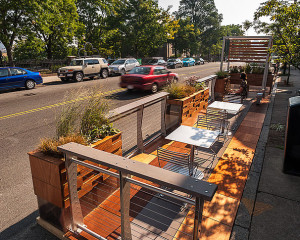Placemaking for Boston
April 13, 2016
[caption id="attachment_1601" align="alignleft" width="300"] Photo credit: Christian Phillips[/caption]
Photo credit: Christian Phillips[/caption]
On April 8th A Better City convened the first meeting of the Interagency Working Group for the Go Boston 2030 Public Realm Planning Study and Action Plan. This project is part of the Go Boston 2030 initiative coordinated by the Boston Transportation Department. The study and action plan aims to unleash the power of placemaking and other forms of urban improvement in transforming Boston’s public realm related to transportation networks. As defined by our study, placemaking is a people-based approach to planning and design of public realm, focused on elements that enhance the experience of living, working and playing in a place. Examples of placemaking include the closure of streets for cultural festivals or recreational activities, or transforming on-street parking into temporary pocket parks. Public realm is a broader term for public space. It defines public space as all publicly owned spaces in the city, not only squares and parks.
The core objectives of the Public Realm Planning Study and Action Plan are to celebrate local placemaking initiatives, identify implementation challenges, and enable public realm interventions through regulation reform and new guidelines. In Phase I of the study, David Dixon, a principal of Stantec, led the analysis of the state of the public realm in Boston, a survey of inspirational ideas, and the development of an analytical method to assess the effectiveness of placemaking, which he presented at the Interagency Working Group meeting.
During the April 8th meeting, six city departments presented their current public realm and placemaking initiatives. The major takeaway was that local government is working hard to transform Boston’s public realm into a more vibrant and inclusive place. The Boston Redevelopment Authority continues to ensure a human-centered public realm through guidelines. Public Works is investing in transforming our streets into corridors for people, not only cars. The Boston Art Commission just launched a new Public Art and Design Application, streamlining the application process for public art. New Urban Mechanics leads the way in placemaking innovation with its annual Public Space Invitational. The Participatory Budgeting Project led by the Mayor’s Youth Council invites the youth to allocate funding for placemaking projects.
Boston witnesses a plethora of public realm initiatives led by the City, nonprofit organization, and community groups. The next step for the study is drafting a set of preliminary guidelines that would provide cohesion to the different initiatives taking place in the city. Furthermore, we will test those guidelines through the development of conceptual designs for pilot areas. Later this year, the study will conclude by preparing final guidelines and strategies for implementation and governance of the placemaking process in Boston.
Comments (0)
- 1




